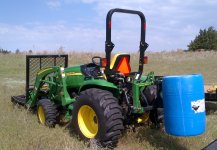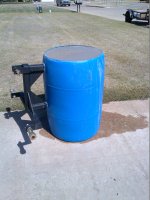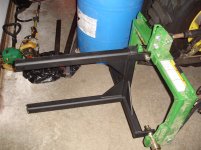You're making a common mistake here. The point of the
ballast is not only to keep your rear planted, but to take weight off the front axle by levering it over the fulcrum of the rear axle. Loaded tires provide additional traction and to keep the rear of the tractor on the ground, but because the weight of the ballast is centered over the axle and resting on the ground, it does nothing to take weight OFF the front axle and transfer it TO the rear axle. Ballast on the three-point is out behind the rear axle, and so it transfers weight OFF the front axle and ONTO the rear axle. This is critical, because the front axle of compact tractors is not designed to take the full weight that the loader can lift.
In short: if you need additional traction, ballasted tires are good. If you need a lower CG for side-hill stability, ballasted tires are good. But ballasted tires do nothing to save your front axle. Three-point ballast is mandatory on most compact tractors for achieving maximum loader lift capacity, whether you have loaded tires or not.




